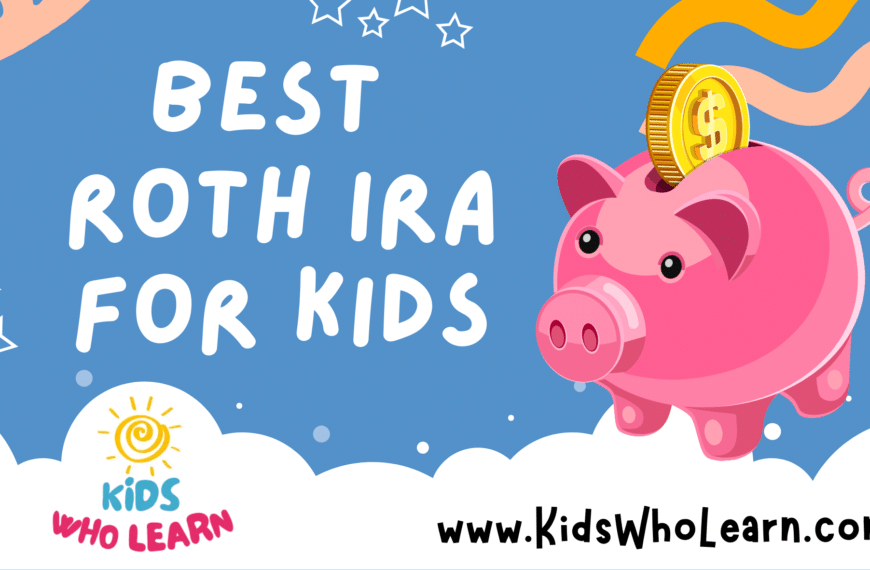Investing in stocks is a practical way to introduce kids to the world of personal finance and jumpstart their journey towards financial literacy. When selecting stocks for children, it’s important to look for companies that are not only performing well but are also relatable to the young investor. This could mean focusing on kid-friendly brands or companies that align with interests that kids understand and find exciting.
It’s also essential to use the right tools and strategies when investing for kids. These should be designed for a long-term approach, considering that investments made in childhood have the potential to grow significantly over time. Along with investing, it’s equally important to educate children about financial principles, enabling them to make informed decisions about money as they grow older. Taking the first step by opening an investment account for your child can set the foundation for a bright financial future.
Key Takeaways
- Select stocks relatable to children that have potential for long-term growth.
- Utilize tools and strategies focused on long-term investing for kids.
- Combine investing with financial education to support your child’s financial literacy.
Understanding Investing Basics
https://www.youtube.com/watch?v=vEdrUIDBkTk&embed=true
Before you begin investing in stocks, it’s essential to grasp the basics of the stock market, the types of investments available, and the appropriate investment accounts for children. This knowledge will guide your decisions and help manage your expectations.
The Fundamentals of the Stock Market
The stock market is a network of exchanges, like the New York Stock Exchange (NYSE) and NASDAQ, where shares in public companies are bought and sold. Owning a stock means you have a piece of a company, and as a shareholder, you can benefit from the company’s growth through dividends and price appreciation. Two key principles of stock market investing include diversification—spreading your investments across various sectors to minimize risk—and understanding market volatility—the natural rise and fall of stock prices over time.
Types of Investments
There are several types of investments that cater to different goals and risk tolerances:
- Stocks: Individual shares of companies.
- Funds: Such as mutual funds, which pool money from many investors to buy a diversified portfolio of stocks, and exchange-traded funds (ETFs), which are similar but trade on an exchange like a stock.
- Index Funds: A type of mutual fund or ETF designed to track the performance of a specific market index, like the S&P 500.
- Dividend Stocks: These stocks pay out a portion of their profits regularly and provide a source of income.
Each type has its own risks and benefits, so it’s important to understand which investment aligns with your financial goals and time horizon.
Investment Accounts for Kids
Children can own stocks through various investment accounts designed to secure their financial future:
- Custodial Accounts (UTMA/UGMA): Accounts where an adult manages assets for a minor until they reach adulthood.
- Custodial IRAs: Both traditional and Roth IRAs have custodial versions. A Custodial Roth IRA is particularly advantageous since earnings can grow tax-free.
- 529 Plans: These savings plans are specifically for future education costs but are less versatile than custodial accounts.
- Joint Brokerage Account: An account shared between a parent and a child, offering an opportunity to manage investments together.
When considering these accounts, think about factors such as tax implications, control over the account, and investment options. Your choices should align with long-term goals like education, first car purchase, or even retirement savings for your children.
Selecting the Right Stocks for Children
When considering stock investments for children, the goal is to choose options that offer educational value, are recognizable to them, and have the potential for long-term growth. Here’s how you can approach this task.
Criteria for Kid-Friendly Stocks
Kid-friendly stocks should generally be from companies with solid fundamentals and a history of steady growth. Look for stocks that are likely to be around as your child grows, synonymous with longevity and stability. These stocks often pay dividends, which can be a tangible way to show children the benefits of long-term investment.
- Dividend Yield: Prefer stocks with a reliable and consistent dividend history.
- Brand Familiarity: Choose companies easily recognizable by children.
- Financial Stability: Strong balance sheets and steady earnings are indicative of lower risk.
Popular Stocks in Familiar Companies
Investing in companies children know and love can increase their interest in personal finance. Brands such as Disney (DIS), Apple (AAPL), and McDonald’s (MCD) not only resonate with kids but have historically provided sound investment returns.
- Entertainment and Toys: Disney (DIS), Netflix (NFLX), Mattel (MAT), Hasbro (HAS)
- Technology: Apple (AAPL), Alphabet/Google (GOOGL), Microsoft (MSFT)
- Consumer Goods: McDonald’s (MCD), Coca-Cola (KO), Nike (NKE)
Educational Value and Financial Habits
Investing in kid-friendly stocks is an excellent way to impart lessons on financial literacy and build strong financial habits. Engage with your child by tracking the performance of familiar stocks. Utilize story-driven companies, such as Walt Disney, to explain the correlation between business operations and stock performance.
- Financial Education: Discuss the importance of long-term investment strategies and the role of dividends in earning passive income.
- Tracking: Regularly review stock performance to teach about market dynamics.
- Personal Finance: Use stock investments as a tool for broader education in personal finance.
Tools for Investing in Stocks for Kids
When introducing children to investing, you’ll want tools that are tailored for young users with safety features and educational resources. Specially designed investing platforms and apps with parental control options are essential for monitoring and guiding your child’s investment journey.
Investing Platforms and Apps
- Acorns Early: A feature within the Acorns app designed for kids’ investments. It allows you to open a UTMA/UGMA account that invests spare change through the roundup feature.
Feature Description Automated Investing Rounds up purchases and invests the change. Potential Growth Investments are diversified across a portfolio. Educational Content Provides financial literacy content for families. - Stash Invest: Offers a platform where you can set up a custodial account for your child. You’re able to invest in fractional shares, making it accessible.
Feature Description Fractional Shares Allows investing in smaller, more accessible portions of stocks. Stock-Back Card Earns stock as you spend using the Stash debit card. Education Includes educational content to teach kids about investing. - UNest: A simple investment app for kids where you can create a UTMA/UGMA account with a monthly subscription fee.
Feature Description Gift Contributions Friends and family can contribute to your child’s investment account. Tax Advantages Potential tax benefits under the custodial account structure.
The Role of Parental Control
- Greenlight: This app features a debit card for kids with parental controls that allow you to oversee transactions and manage how funds are spent.
Key aspects:
- Real-time notifications provide instant updates on spending activity.
- Store-specific controls give you the ability to approve or decline where your child can spend money.
- Acorns & Stash: Both offer features for parental control. With Acorns Early you can monitor investments made for your child, while Stash includes a custodial account that allows children to learn about investing with a parent’s oversight.
Parental features include:
- Automatic investment plans: Set and forget features that invest a set amount regularly.
- Educational resources: Tools and information that help teach financial concepts.
- Parental Involvement: Regardless of the platform, parental involvement in setting up and managing accounts is crucial. You can assist in selecting investments and tracking progress while using these opportunities to impart valuable financial lessons.
Strategies for Long-Term Investing
When investing for the long term, it’s critical to grasp the relationship between risk and return and the power of regular contributions to your investment portfolio.
Understanding Risk and Return
You need to recognize that all investments carry some degree of risk, and generally, the higher the potential return, the higher the risk. A diversified portfolio can help you manage this risk better. For example, it’s wise to spread your investments across various asset classes such as stocks, bonds, and real estate, which can balance the performance of your portfolio.
| Risk Level | Types of Investments | Potential Return |
|---|---|---|
| Low | Government Bonds | Minimal |
| Medium | Corporate Bonds | Moderate |
| High | Equities | High |
With long-term investments, you have the opportunity to ride out market fluctuations and potentially receive higher returns over time.
The Importance of Regular Contributions
Consistently contributing to your investments is fundamental to building wealth through long-term investing. Even small regular amounts can compound significantly due to the effects of time and reinvestment of returns. Your investment strategy should include budgeting for saving, emphasizing the payout ratio, which is crucial for investments like stocks where you may expect dividends.
- Establish a savings goal: Define what you are saving for and determine the timeline.
- Allocate funds consistently: Automate your saving to ensure you contribute regularly.
- Reinvest returns: Consider reinvesting dividends to take advantage of compounding.
Remember, persistence in regularly contributing to your investments will bolster your efforts towards a robust long-term investment portfolio.
Next Steps: Opening an Investment Account
After selecting the best stocks for children, the next step is to establish the right kind of investment account. This process involves choosing an account type tailored to minors, selecting appropriate investment vehicles, and managing the portfolio effectively.
Setting up a Custodial Roth IRA
To begin investing on behalf of a minor, create a Custodial Roth IRA. This type of Individual Retirement Account (IRA) is controlled by a custodian—usually a parent or guardian—until the child reaches adulthood. Open a Custodial Roth IRA with institutions like Vanguard or Fidelity that are known for their solid track record in money management.
Contributions to a Roth IRA are made with after-tax dollars, so the funds can grow tax-free, and qualified withdrawals in the future are also tax-free. Since children typically fall into a lower tax bracket, the tax benefits are advantageous.
Choosing a Mutual Fund or ETF
For the investment itself, consider a diversified approach with mutual funds or exchange-traded funds (ETFs), which can provide a balanced and diversified portfolio. For instance, Vanguard Total Stock Market ETF or Vanguard Total World Stock ETF offer broad exposure to the stock market.
- Mutual Funds: A mutual fund pools money from many investors to buy a diversified portfolio of stocks or other securities. Fidelity Mutual Funds is among the providers offering a range of options suitable for a long-term investment strategy.
- ETFs: ETFs trade on an exchange like stocks and can be a good option for dynamic portfolio management. They also generally come with lower expense ratios, making them a cost-effective choice.
Monitoring and Managing the Investment
Once the account and investments are in place, consistent monitoring and managing are crucial. This doesn’t mean daily changes but regular reviews to ensure the investment aligns with your long-term goals.
- Review Periodically: Check the account quarterly or yearly to assess performance.
- Rebalance when necessary: If certain investments grow or shrink significantly, rebalancing helps maintain the original asset allocation.
By taking these steps, you are not only investing in your child’s future but are also teaching valuable lessons in financial literacy and personal finance.
Supporting Your Child’s Financial Education
Educating your child on financial literacy is vital from an early age. It helps them develop good money management skills and sets them on the right path to making informed investment decisions.
Teaching the Value of Money Management
Education on personal finance should start with the basics: money management. You can begin by opening a savings account in their name, teaching them to track expenses, and set savings goals. Greenlight offers cards designed for kids to learn about money management under parental supervision. Additionally, introducing concepts like budgeting can be done using clear and engaging methods.
Games and Activities for Learning
Board games such as Monopoly and The Game of Life, as well as online games, can introduce financial concepts in a fun way. These activities not only teach valuable lessons about money and investing but also allow children to practice these skills in a simulated environment, enhancing their financial literacy.
Using Practical Examples
Provide your children with practical examples of financial transactions. When shopping, explain why you choose one product over another, considering cost and value. Pointing out the difference between wants and needs is also a beneficial lesson in personal finance.
Providing Real Investment Opportunities
Create a custodial account, such as a UTMA, to give your child a first-hand experience of investing in real stocks. Stocks for kids should be chosen based on companies they know and have an interest in. This direct involvement will help them appreciate the value of investing and the long-term benefits it can yield.
Innovative Investment Themes for Kids
Investing in stocks that cater to the interests and future of kids means focusing on industries that are growing and shaping the world they’ll live in. Here are some forward-looking investment themes you might consider for a child’s portfolio.
Sustainable and Renewable Energy
When you invest in companies that are at the forefront of sustainable and renewable energy, you’re supporting a cleaner future and betting on sectors poised for long-term growth. Look for stocks in solar, wind, and electric vehicle companies that are making significant strides. For example, Tesla has revolutionized the electric vehicle market with its innovative cars and energy solutions.
Technology and Entertainment
Your investment in the technology and entertainment industry captures the dual aspects of innovation and fun. Alphabet, Inc. (Google) is a giant in the technology sector, with its ubiquitous Google Search engine and other ventures like artificial intelligence and self-driving tech. For entertainment, companies like Netflix and Walt Disney offer streaming services that are immensely popular among all age groups, especially kids. Hasbro, with its strong foothold in branded entertainment, represents another relevant investment that resonates with the youth.
Targeting Companies with a Youth Focus
Focusing your investments on companies that directly cater to younger demographics can be a strategic move. Brands like Target have a wide range of products that appeal to kids and families, making them a potential staple in an investment portfolio aimed at children. Additionally, Instagram, a platform engaging a younger audience through social media, is owned by Facebook, Inc. (now Meta Platforms, Inc.), which may provide a tech-savvy angle to your investment choices.
Frequently Asked Questions
When selecting stocks for teenagers or planning a child’s financial future, consider their potential for growth, the business’s stability, and sectors that interest the young investor to maintain engagement and learning.
What are some appropriate stocks for teenagers interested in investing?
Technology and consumer companies often appeal to teenagers, as they are likely familiar with these brands. Companies like Apple, Microsoft, and Nike could be considered because they offer a combination of growth potential and are well-recognized brands.
What criteria should one consider when choosing stocks to invest in for an 18-year-old?
Focus on stocks with long-term growth potential. Look for financially sound companies with strong fundamentals, diverse revenue streams, and a history of performance. It might also be wise to include stocks that align with an 18-year-old’s interests and values.
Which investment options are best suited for a newborn’s financial future?
Consider establishing a 529 college savings plan or buying shares in broad-market index funds that offer exposure to a diversified portfolio. These tend to be lower-risk options with the potential for steady growth over time.
Can you suggest some fun and engaging stocks that would be suitable for young investors?
Stocks in the entertainment and gaming sectors, such as Disney and Activision Blizzard, are engaging to young investors and can teach them about investing in industries they already have an interest in.
What are the most recommended mutual funds for children’s long-term investment?
Look for mutual funds with historical consistency, low expense ratios, and a focus on diversified holdings. Tax-efficient funds like growth stock mutual funds can also be appropriate for children’s long-term investment strategies.
What steps should a parent take to start investing for their child’s future?
First, open a custodial account that transitions to the child at the age of majority. Then, create a diversified portfolio that aligns with your long-term goals and risk tolerance. Regularly contributing to this account can help build the investment over time.









